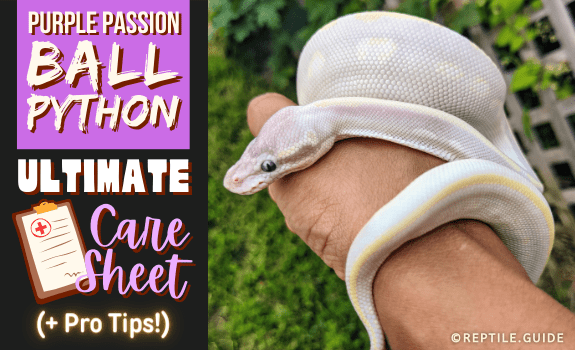The purple passion ball python is one of the most fascinating colored morphs on the market.
Although this purple ball python is an unusual color, it requires similar care to any other ball python.
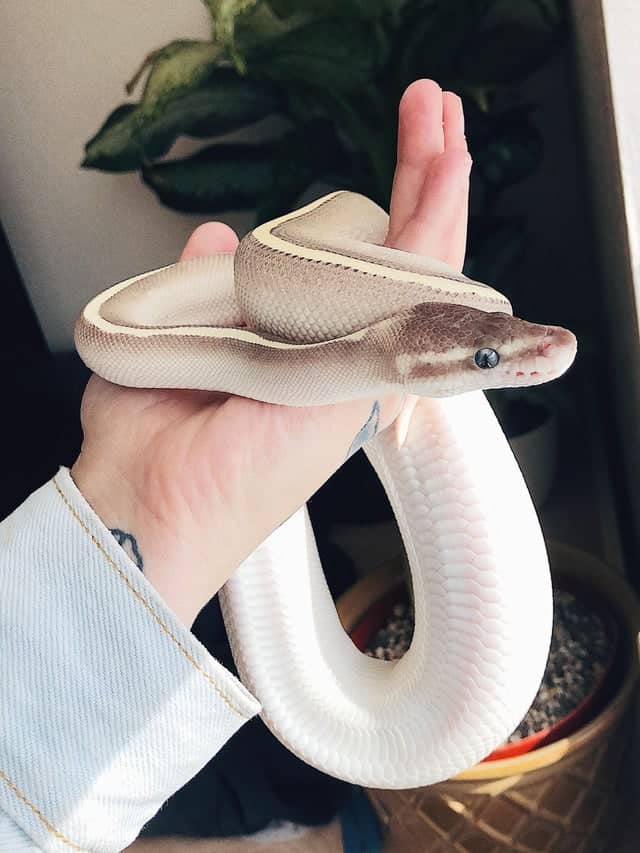
Image credit: u/glhai (via Reddit.com)
We’ll take a closer look at this purple python snake, discussing things like:
- Where to buy a purple passion ball
- How to care for a purple passion morph
- How much do purple passion ball pythons cost?
- Which other color morphs come from the purple passion?
In This Article
Purple Passion Ball Python Price
You can expect to pay around $400 for a young purple passion ball python.
Older ball pythons will have higher price tags, possibly by several hundred dollars.
You may also find morphs and crosses produced with purple passion ball pythons. Their prices will vary, depending on the other morphs involved.
Crosses involving rare morphs will cost far more than crosses involving common morphs.
Where to Buy Purple Passion Ball Pythons
The best places to buy ball pythons include:
- Directly from the breeder
- Online reptile marketplaces
- Reptile conventions and expos
Many different places sell the purple passion color morph. However, not all of them are the best places to buy a ball python.
We don’t recommend buying from:
- Pet stores
- Supermarkets
- General (not reptile or animal specific) online marketplaces
This list includes places where the snakes are just another product. Even the best-intentioned employee isn’t always knowledgeable enough to care for a python.
Our recommended dealers all offer the opportunity to talk to experienced keepers and breeders of the purple passion morph.
The following sections will discuss our recommended options in more detail.
Directly From the Breeder
Buying color morphs directly from a breeder is one of the best strategies. Many professional breeders have websites and offer door-to-door shipping.
It’s a good idea to ask around on reptile forums and review websites. Some of your fellow reptile enthusiasts can share their past experiences with a breeder.
Purchasing directly from the breeder also allows you to ask questions about how they keep their animals.
Online Reptile Marketplaces
Online reptile marketplaces like MorphMarket host breeders from around the country.
Since the websites offer legal protection for buyers, you can buy through them with an easy mind.
These marketplaces often feature hundreds of color morphs, making it a convenient place to find exactly what you’re looking for.
The seller will courier your snake, and you’ll have your new pet within 48-72 hours.
Reptile Conventions and Expos
If you prefer the personal touch, then reptile conventions (a.k.a Repticon) and expos are ideal places to buy ball pythons.
The organizers of the event host breeders from around the country. You’re almost guaranteed to find at least one breeder with the morph you want.
The advantage of buying at these events is that you get to see the animals before you buy.
You also get to talk to the breeder about the animal’s background.
Purple Passion Ball Python Appearance
These ball pythons have the generic build of ball pythons everywhere—a robust head, and a bulky body.
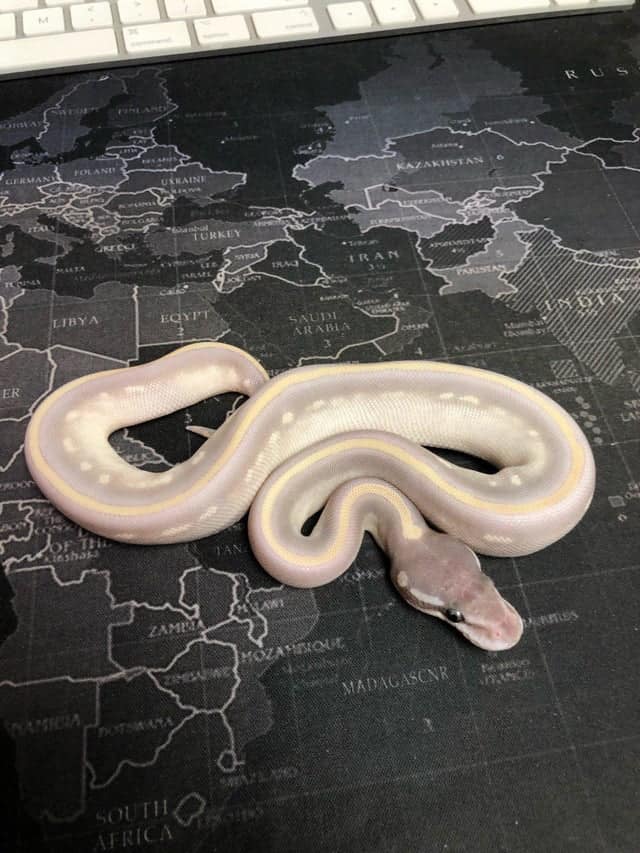
Image credit: u/purpleunicorntacos (via Reddit.com)
However, the purple passion morph doesn’t have the same pattern as wild ball pythons.
These animals have a long stripe down their spines and are a similar color to the lavender albino ball pythons.
How Big Do Purple Passion Ball Pythons Get?
This morph has average lengths of between five and six feet. Purple passion pythons reach a similar size to other ball pythons.
Females are usually slightly larger than males, reaching up to six feet in length. Males tend to stop growing at five feet in length.
Caring For Purple Passion Ball Pythons
Caring for ball pythons doesn’t have many requirements. Irrespective of the morph involved, the care for ball pythons remains the same.
The following sections will cover the basics of caring for ball pythons.
Enclosure Size
When planning a home for your new ball python, bear in mind that you’ll have to upsize the enclosure from time to time (more on that in our ball python enclosure guide).
Young hatchlings require a 10-gallon tank, then will move on to a 20-gallon, and adults require a 30-40 gallon enclosure.
You can expect to buy an enclosure every year for the first three years, after which the python is fully grown.
Substrate
Ball python substrates are an essential part of their care. The right substrate:
- Helps moderate humidity levels
- Makes it easier to clean the enclosure
- Assists the python in having healthy sheds
The wrong substrate may be an impaction risk or prevent the snake from living its life to the fullest.
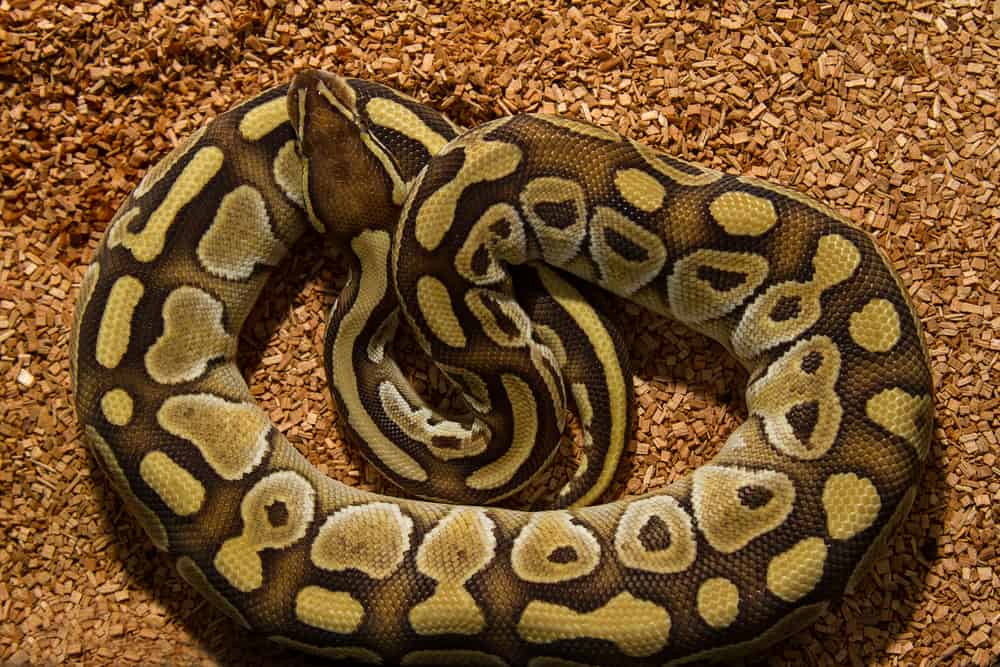
Some of the best ball python substrates include:
- Newspaper
- Paper towels
- Paper pellets
- Bioactive soil
- Coconut husk
- Cypress mulch
- Aspen shavings
- Orchid/Repti Bark
All of these substrates work well, though not all achieve the same results.
Paper-based substrates are easy to clean, but are not the best for maintaining humidity levels.
Substrates like coconut husk and cypress mulch are fantastic for maintaining humidity.
In the end, it comes down to what you and your pet snake prefer.
Heating and Humidity
Like all reptiles, ball pythons need a temperature gradient in their enclosures.
This is because snakes have no system for adjusting temperatures internally.
They move between warm and cool spots to keep their body temperature in range.
You can easily accomplish a temperature gradient for your ball pythons and other cold-blooded animals.
If you heat only between one-third and one-half of the enclosure, a gradient will form naturally.
We recommend a basking light or ceramic heat emitter, which simulates basking in the wild.
Aim to provide the following temperature ranges in different parts of the enclosure:
- Cool side – 76-80°F
- Warm side – 88-92°F
- Ambient temperature – 81-83°F
- Night-time temperature – 70-75°F
Although ball pythons come from tropical climates, they don’t have high humidity needs. Aim for a relative humidity of 50-60%.
If you’re using an appropriate substrate, you can easily maintain these humidity levels by keeping the water bowl full and misting regularly.
We recommend using two to three thermometer/hygrometer combos in the enclosure.
Having one on each side of the enclosure will help monitor all the temperature zones.
A third, central, device is useful for monitoring ambient temperatures.
If you want to protect your pet snake from health issues, providing a temperature gradient and appropriate humidity level is essential.
Lighting
Ball pythons, as a species, don’t have intense lighting needs. Typically, these snakes will thrive if they have a day and night light cycle.
If you’re using heat lamps to heat the enclosure, you won’t need additional lighting.
Just ensure that the snakes have 12 hours with light every day, and 12 hours without.
You may need a backup heating system that doesn’t produce light, like a ceramic heat emitter or heating pad, to warm the enclosure at night.
While ball pythons don’t need high temperatures at night, temperatures may drop too low in cold areas.
If you’re not using a heat lamp, you’ll need supplemental lighting.
While ball pythons don’t need UVB lighting to survive, we recommend using it either way. It can help keep your snake’s immune system strong, and enhances coloration.
UVB bulbs fit in any standard heat lamp socket. You can also add a timer to your lighting system to ensure that the day and night cycle stays consistent.
Security and Setup
Apart from an appropriate substrate, your ball python needs very little to feel safe and secure.
We view the following three items as essential for keeping your snakes:
- Hides
- A water bowl
- Objects for climbing on
While snakes are predators, they’re also prey items.
Thousands of years of being hunted by mongooses, birds, and large mammals have taught snakes to have a ready hiding place.
For this reason, your snake needs a hide to feel secure. We suggest having the following:
- A humid hide
- A hide on the cool side
- A hide on the warm side
This setup will allow your snake to moderate its temperature when it’s resting.
A humid hide is a hide filled with damp substrate. It has higher humidity than the surrounding enclosure and helps to prevent shedding problems.
The water bowl serves three purposes. It:
- Allows the snake to drink water
- Helps to maintain the enclosure’s humidity levels
- Gives the snake a place to soak its old skin before shedding it
Although these snakes are primarily terrestrial, they love to climb. Giving them objects to climb over and through will help them to feel secure.
Diet
Most snakes around the world eat a similar diet consisting of smaller animals.
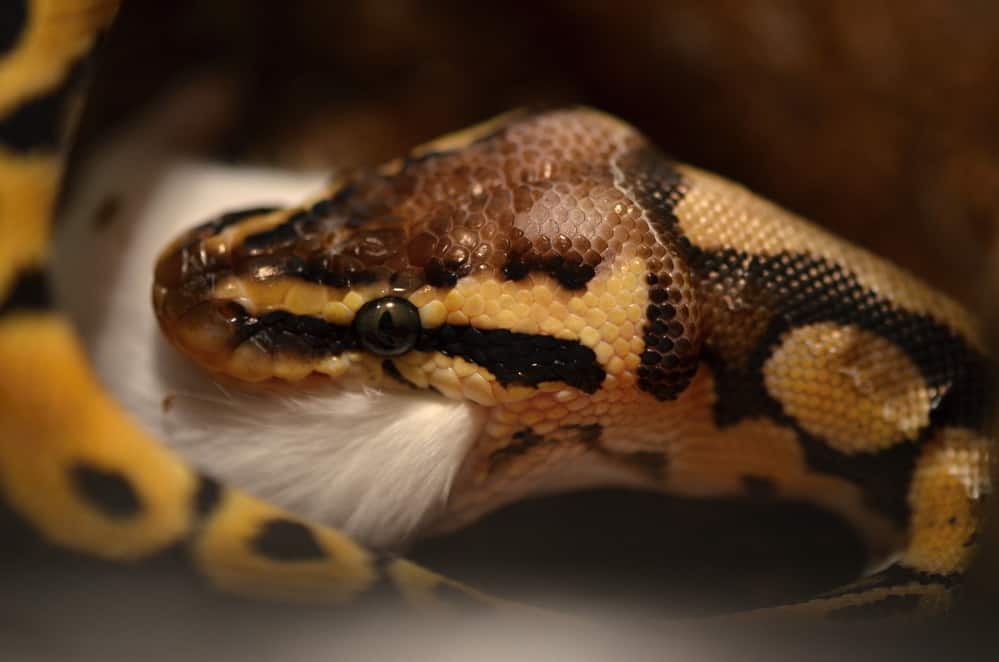
In the wild, ball pythons dwell near water sources where they mainly feed on amphibians, reptiles, rodents, and small birds.
In captivity, these pet snakes mostly eat rodents. To prevent health issues, it’s important to feed them a variety of feeder animals.
Some of the options include:
- Rats
- Mice
- Chicks
- Feeder Lizards
Young pythons, under a year old, need to eat once a week. Older animals need a meal every 10-14 days.
As a rule of thumb, never feed your pet snake a prey item that’s larger than the thickest part of the snake’s body.
If you’re looking for a reliable ball python food and supplies online store, we recommend Chewy! It is the most trusted and convenient online destination for reptile pet owners.
Click here to save 30% on your first order. We may receive a small commission if you purchase after clicking.
This DOESN’T change what you pay or what we recommend. It does help fund the research we put into the site, and we’re grateful for any support!
What are Purple Passion Ball Python Morphs?
The purple passion morph is one color morph of the ball python, Python regius, species.
Color morphs are similar to a breed of dogs or cats. While all the different breeds are the same species, genetics allow for hundreds of appearances.
NERD first produced these snakes in 2007, and this particular morph is a cross between the Mojave and phantom genes.
In the wild, ball pythons didn’t have the chance to live out their genetics.
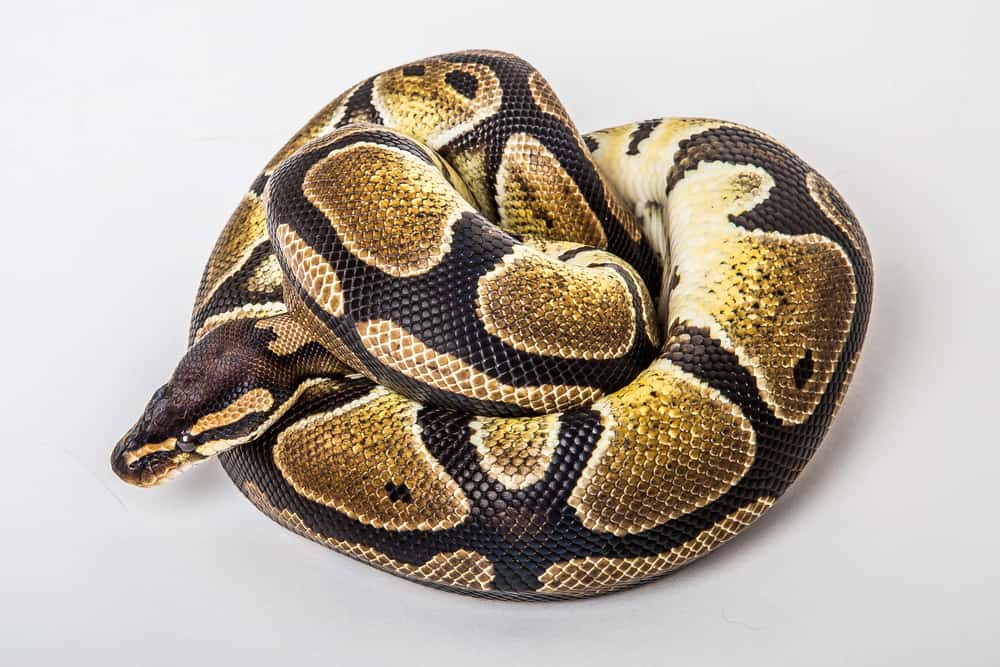
Though these gorgeous snakes had the potential for many colors and patterns, unusually colored snakes were quickly killed by predators.
In captivity, breeders were able to breed oddly colored snakes to create new colors and patterns.
Each of these established patterns is a morph. They range from the Mojave to the Phantom and the Purple Passion.
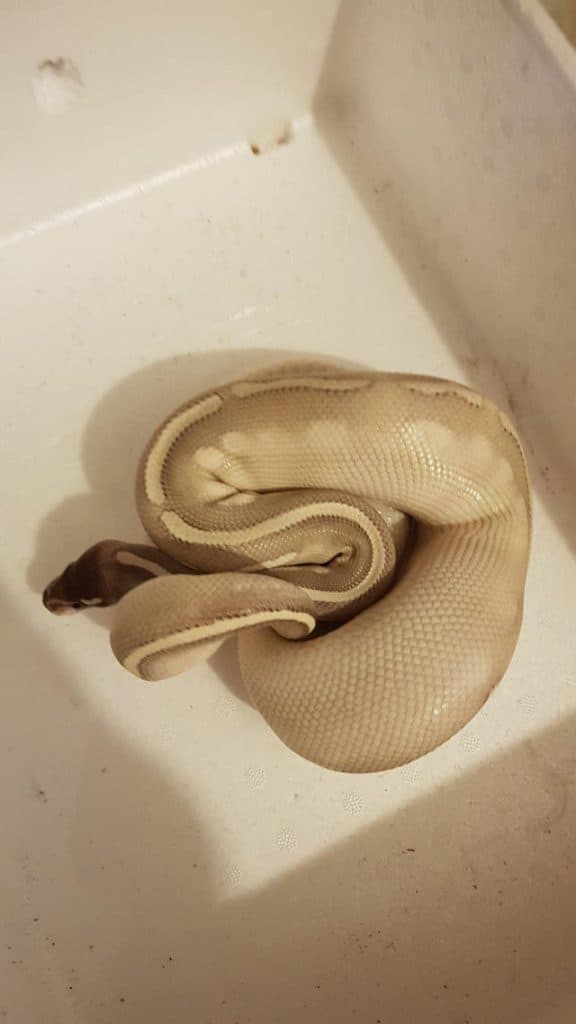
Image credit: u/sammum4 (via Reddit.com)
Essentially, a morph has the genetic code for a specific appearance and that code can be reliably passed on to future generations.
Purple Ball Python Morphs
While these snakes are gorgeous, there aren’t many purple morphs on the market.
Almost every purple morph is more salmon or pink than purple. Breeders from around the world have been trying to create a truly purple snake.
However, for the moment, it’s only the odd snake that has noticeably purple coloration.
The following segments will take a closer look at a few of the purple morphs.
Mystic Potion Ball Pythons
Mystic Potion ball pythons are one of the slightly more purple morphs.
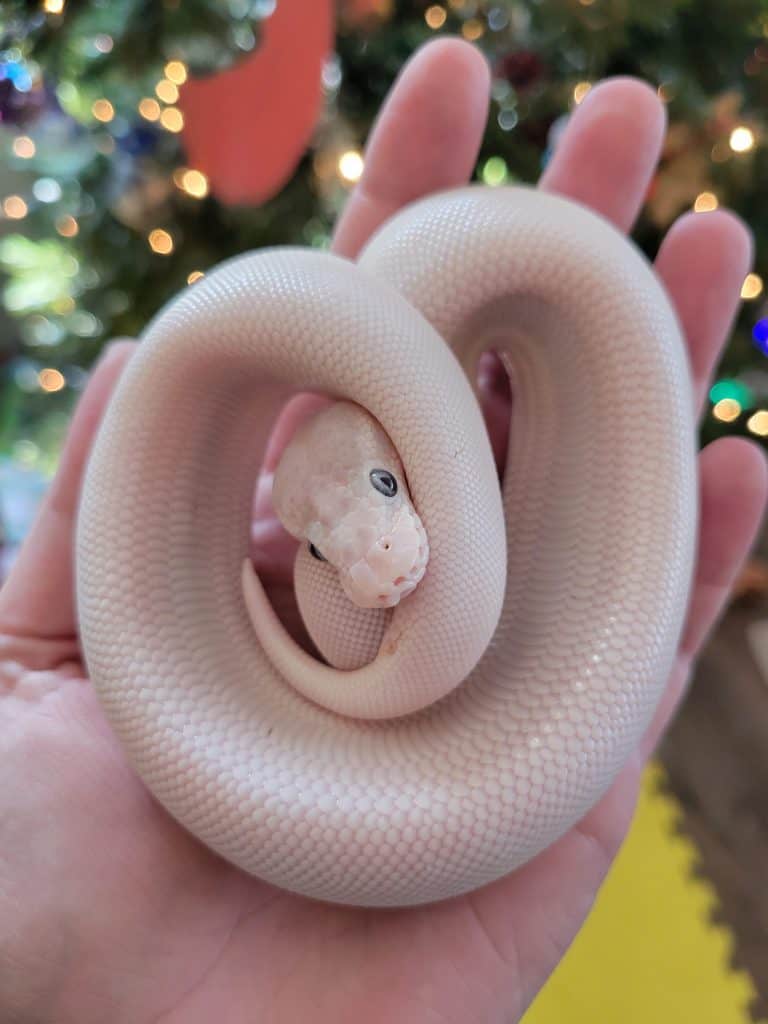
Image credit: u/narmowen (via Reddit.com)
Breeders were able to create this morph by crossing the co-dominant Mojave gene and the co-dominant mystic gene.
Since both genes are co-dominant, many crosses exist with morphs like the super pastel and the spider.
Purple Haze Ball Pythons
The purple haze morph is a gorgeous cross of the following genes:
Thanks to its many genetic influences, this snake may still turn out to be fundamental in creating a vibrant purple ball python.
We hope you’ve enjoyed this article about the purple passion ball python.
Are you concerned about your ball python biting you? Check out our article about ball python teeth and biting to learn how to prevent, and deal with, python bites.
Which purple morph is your favorite? Let us know in the comments.
